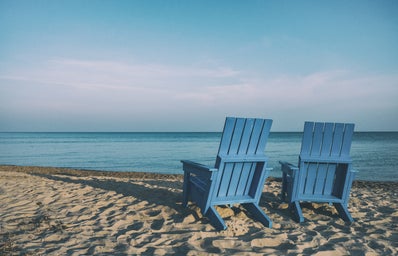DEWEY BEACH, DE – Dewey Beach is a small town nestled into the coast of Delaware. To the south is a stretch of land with nothing much populating it except for a dusty beach highway, wetlands, and some McMansions raised ten feet above sea level by wooden stilts. To the north is Rehoboth Beach – a town interwoven into Dewey by a trolley line and miles of sandy shore with no set border. Dewey attracts a crowd of predominantly college students who work odd jobs over the summer in between semesters at the University of Delaware. Beyond them, the town is home to a small but mighty year-round population of retirees, young families, and others who work in Wilmington or Dover by weekday and lounge in an almost destitute beach town on long weekends and holidays.
Dave and Nancy Giacomini first started visiting Dewey in 1992. When they had children they purchased a beach house about two blocks from the bay and another three from the Atlantic with Nancy’s sister and brother in law, Sue and Scott Layne. Sue has been coming to Dewey since 1988. The family named their new cottage Sibling Revelry for rental purposes, painted it yellow, and installed a hot tub in the backyard. On a wooden shelf within the house is a little seafoam colored guest book containing stories from years of renters. They praise the rustic charm of the house built in the 1960s, the short walk to the bay where they hunt horseshoe crabs and utilize the house kayaks, and always – the gorgeous stretch of Delaware coastline only a five-minute walk away.
“Every summer, we spend about a month in the beach house. Sue and Scott usually go with two weeks, and the rest is up for rental,” remarked Dave in the kitchen of his more permanent home in Landenberg, Pennsylvania. In the off-season, or the stretch of time between late September and mid-May, Dave and his wife Nancy spend another two months in Dewey, give or take.
Dave’s family has been lucky when it comes to damage from climate change on the property. He remarked that although some homes closer to the shore had seen wear and tear, with his house perched eighteen feet above sea level, on the highest elevation in Dewey, it hadn’t endured much harm.
“The damage that the house has seen is minimal,” remarked Sue. “We’ve lost some shingles and siding, but aside from that, the house has weathered well. Our house, for now, is safe from coastal flooding. However, rising sea level is hurting the town of Dewey, it’s only two blocks wide.”
Back when Dave and his family purchased their home in 2001, climate change was an afterthought. However, they now feel particularly grateful to be at the elevation they’re at. “The properties that flooded back in storms like Sandy were all along the Rehoboth Bay; they were much closer to sea level than us.”
Before Dave had kids of his own, he was a student studying meteorology at the University of Delaware. When asked if he thought his beach house would ever see the effects of climate change, he remarked that it was unlikely within the next fifty to one hundred years. “It would take a catastrophic storm to flood our beach house. The Delaware coast is less prone to severe hurricanes because the hurricanes typically travel up from the south Atlantic and get downgraded before hitting the Delaware coast. This is due to the Outer Banks in North Carolina absorbing the force through its landmass.”
“We are getting stronger storms, though,” remarked Sue, “We saw the effects of Sandy, we’re getting more nor’easters than usual, and we’re experiencing more extremely hot summers and mild winters than I can ever remember.”
Massive, detrimental storms have happened in Dewey. The storm of 1962 is often referred to as the worst in recorded history, even beating out Hurricane Sandy which decimated the Jersey coast in 2012. A three day nor’easter, the storm created hundreds of millions worth of damage, claimed seven lives in Delaware (forty in total), and flooded the entire town of Dewey so badly that the ocean and bay met in some places. Delaware has avoided a similar catastrophe for the past sixty years, however, it serves as proof that when it comes to nature, anything is possible.
“I have worried about the long term effects that climate change may have on rentals,” said Sue, “although I think we’re in a safe place flooding wise, if some of the coastal properties start to flood that could affect business and could lessen the value of the house in the long run.”
Sibling Revelry may withstand the forces of nature for the time being, yet Dave and Sue have both noticed changes being made to their coastal town to remediate the effects of nature. Older homes are being remodeled and lifted; homes built on the ground often flood. As for the beach itself, replenishment occurs every 5-7 years where sand from the deep ocean floor is dredged up and moved closer to shore to protect the coast from diminishing. This replenishment has cost Delaware approximately $66 million since 2013. Rehoboth and Dewey took the biggest percentage of the funding at $24 million. Although widening the beach protects coastal infrastructure and a tourism heavy economy, the coast is also Delaware’s best defense against storm surges.
Long-term erosion and sea-level rise is a more withstanding issue that Delaware will slowly come to face. Sibling Revelry’s closest water access is a boating launch two blocks from the house. Tides change throughout the day, however, what was a small beach about ten years ago is now completely gone.
Although the coast is slowly shrinking, the amount of tourists and permanent residents in Dewey and Rehoboth is increasing. Coastal restoration projects are huge in combating rising waters, however, the Delaware coast is still eroding at a rate of one meter per year with the coast of the bay eroding even faster; at a rate of 10 meters per year in some places. Dewey sits on a piece of land directly in between these two encroaching water masses.
In 2019, the state of Delaware welcomed a record-setting number of 9.2 million tourists, this is an increase of over 2 million people from 2010. Route 1, the only stretch of highway connecting the beaches to the rest of Delaware, gets so congested on summer weekends that many long term residents now refuse to make even a mile-long car ride in the height of the summer. In Dewey, a new set of condominiums recently opened making way for hundreds of new residents and renters, and new hotels and homes in Rehoboth are ever occurring. The beach in Rehoboth gets so packed with tourists on the weekends that some will make the trek to less crowded Dewey to avoid the rows of umbrellas stacked in the sand. Gentrification in Northern Rehoboth and new developments do nothing to thwart the ever-expanding tourism industry at the beach.
“The effects of over-tourism seem like a real danger to the beach,” said Sue, “more people means more traffic, more trash, and more boats polluting the bay.”
Dave thinks otherwise, and from an environmental perspective, does not think a rise in tourism is negative, “it’ll help the shore economy, overall.”
On a hot summer day in Dewey, the children of those who vacationed here in college now roll around in the sand dunes, slowly eating away at one of Delaware’s best natural defenses against storms. More and more pontoons enter the Rehoboth bay below the canal bridge, fishing and releasing hazy exhaust on the murky water. Microplastics, cans, and other garbage can be found left behind and washed up on the sandy alcoves of the bay only accessible by boat. Every summer, more hotels, restaurants, and homes are erected. Like the tides, the people keep coming to town and despite it all, still enjoy the shore. For now.



